
To say I was excited by the announcement of Killing Floor 2, when I first received news of it, would be the understatement of the century – I was beyond stoked that one of the most innovative, yet conceptually simple wave-based shooters of recent years was getting its long-overdue sequel. Every day without fail, I’d be googling Killing Floor 2 to see if any news had leaked; New classes? New Zeds? New weapons? It was incredibly exciting, not to mention an excruciating twelve-month long wait. As a huge fan of the first game (clocking up over two hundred hours), this was certainly welcome news for me.
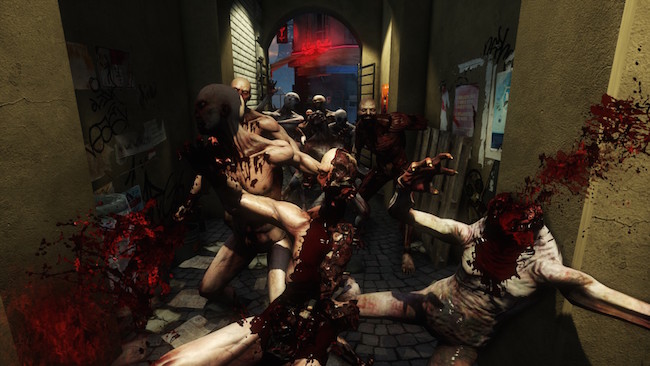
Visually, KF2 follows the lead of its predecessor; that is, it is built off non-current generation technology, instead heavily modifying and redesigning the now aging technology of the Unreal 3 engine (the developers refer to it as the ‘Unreal 3.5 engine’ due to the extensive work they did on it); however it looks absolutely splendid with crisp, sharp visuals, well-designed spaces driving towards photorealism. And the engine technology delivers this very well; with consistently high frame-rates that didn’t even drop with over a dozen enemies and other players all frantically dashing across the screen, not to mention the perma-gore; an ingeniously designed system that adds an invisible cellular ‘layer’ to the world which when cells are ‘filled in’ by blood splatter, simply changes the properties of that layer to make blood permanent without decreasing performance.
Of course, the same furious Zed-slaughtering action is back in spades – the big technological centrepiece being the extremely grisly, graphic dismemberment that the players can inflict into the hordes of monstrosities closing in. Killing Floor 1 had a fairly generic dismemberment system, featuring basic decapitation, headshots and removal of limbs in response to location-based damage. Killing Floor 2 taken this up several levels and have redesigned every Zed with excruciatingly detailed biological anatomy – after a hail of gunfire, the collapsed, bloodied mess of a Zed will have a recognizable oesophageal tract through their bloodied upper torso. Another Zed might have a large hole blown into its abdominal region, showing the disrupted organs left behind, while the last Zed has half his torso blown off, revealing broken bone, torn tissue and internal organs.
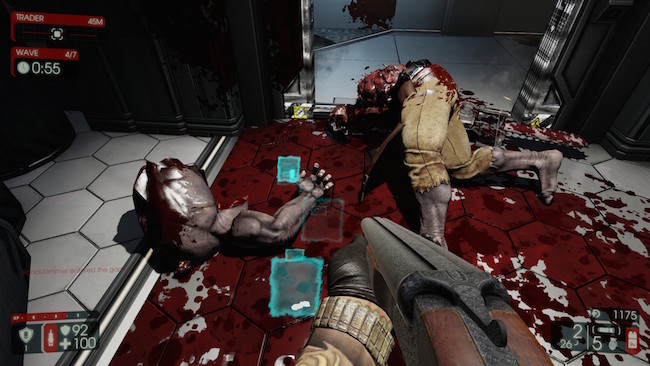
It’s all gruesomely detailed and every single time it’s a visual feast to look at – the injuries the Zeds sustain never come off looking exactly the same every time, especially when higher-power weapons are involved, and it really goes down as a testament to the painstaking efforts that went into designing the engine, the monsters and the most graphic ways to dispatch them.
Killing Floor 2 could easily have the best soundtrack of 2015 to boot; the music is mostly licensed heavy metal tracks with a 2000s Nu Metal/New Wave of American Heavy Metal feel to them, some dark, pumping and aggressive Industrial tracks as well as a few eerie ambient tracks thrown in for good measure. I was relieved to see that one of the biggest charm factors – the cockney banter – from the first game did in fact make a comeback, though this time the character voices are more diverse, with all playable characters having unique voices (unlike the first title, which featured a generic male and female voice for all characters).
This was something of a welcome change which helped the world feel more ‘alive’ – the handful of characters currently available feel that bit more real, and much of the automated voice lines (characters chatting about ammo, their health, etc.) all provide valuable semiotic information to the player in a non-intrusive manner.
Other aspects of the sound design are presented immaculately – the larger, more threatening Zeds (the Scrake and Fleshpound) announce their entry into the map as the music fades out with a loud, distinctive growl.
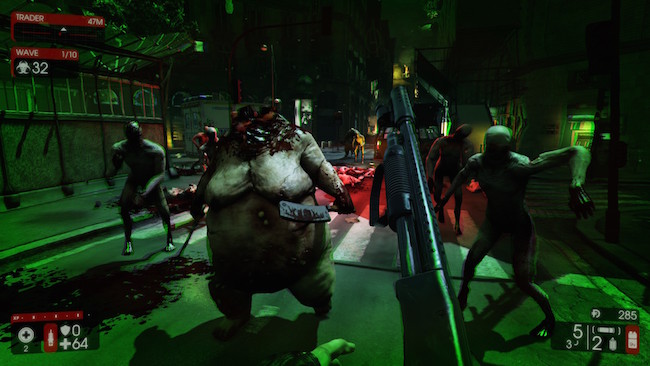
The weapons also benefit greatly from the sound design; they all feel appropriately real and powerful – there’s a great sense of sonic dynamism in a shotgun blast’s booming bass, to be heard against the shrill automatic fire of the assault rifles, while the berserker’s mechanized melee weapons buzz menacingly. The soundscape feels nicely balanced, and never cluttered or cacophonic.
The frantic, fast-paced and often claustrophobic action from the first title is back in spades. Perhaps the greatest overhaul from the first title is the dynamic AI/monster tactics that adjust based on the skill level; for instance in Killing Floor 1, as the difficulty level increases, you would see more monsters with more HP, and some slightly sped-up (and rather stiff-looking) walking animations, while their behaviour would largely remain the same. In Killing Floor 2, the enemy behaviour is fluid and dynamic with vastly improved monster animation; why would animation be so important you ask? Because, the animations and associated movement changes with each difficulty adjustment – a basic monster might shamble towards you, allowing making for easy headshots on easier difficulties, while that same monster on harder difficulties will initiate a full-blown sprint upon sighting you, making a headshot much more difficult.
Other elements have been tightened up and improved from the first game too; no longer is a new player entering a match in progress going to join a game with a fixed amount of money – the starting cash scales to the current round, so new players joining longer running games won’t be left at a financial disadvantage to the others (thus avoiding the inevitable flow-on effect of requiring cash from teammates, or risking repeated deaths).
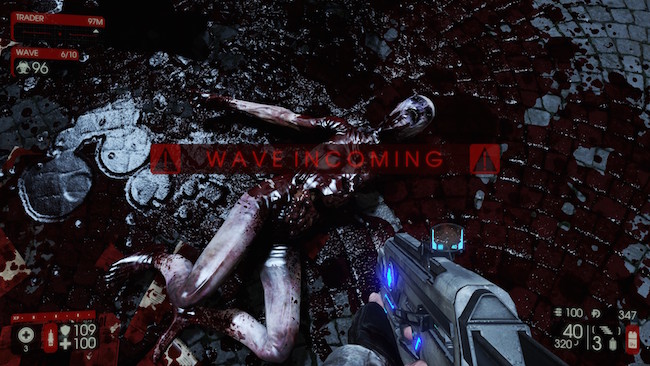
In its early access phase, there’s only four out of the proposed ten classes available to play – though they all handle exceptionally well. Tripwire has rebalanced the Perks system from the first game, so now players will always begin with a base, perk-specific weapon (unlike the first game where all players, unless substantially levelled up would begin only with a basic pistol). This has also helped make the opening rounds subsequently more enjoyable and less of a grind.
Speaking of which, the levels and levelling criteria has received a major overhaul; Killing Floor 1 had very specific criteria each perk had to reach before levelling up; personally, the most frustrating of these was the Commando’s requirement to meet a kill quota for ‘Stalkers’, an enemy-type that remained largely invisible until it closed in on the player to attack them. I can see what Tripwire was going for; one of the Commandos abilities was to see cloaked enemies at some range which other players couldn’t, thus giving him an advantage at spotting them early and dispatching them with a class-appropriate weapon. However, the main problem was that Stalkers often approach the player with a pack of non-invisible enemies, and will often be gunned down by any number of players’ incidental crossfire. Or, they get gunned down by a more advanced Commando with a greater range of sight than you. This often amounted to an insurmountable frustration at something of a levelling bottleneck; although you may have surpassed the damage quota to level up, you’re not getting there until you’ve capped those 500+ stalkers which could take some serious grinding persistence.

Killing Floor 2 has cleverly circumvented this issue by giving all classes a generic ‘XP bar’ – more XP is awarded when the player makes kills with class-specific weapons or meets other XP-boosting criteria (certain monster kills, door welds, etc.) with nominal XP being awarded for non-class specific weapon kills. The end product is a more dynamic XP system that ensures players, no matter whether they use their intended weapon sets or not are still gaining XP, unlike the first game which essentially ground your progress to a halt. It’s refreshing to see that playing a class, even if you’re unable to meet the exact requirements for optimal XP (due to either your main weapon running dry, or an absence of class-specific tasks to fulfil), that you’re still building your overall stats in the process.
The levelling process is much more expansive too – Each perk now has a whopping twenty-five levels to raise in total, with incremental increases in stats happening along the way. Every five levels there now is a class-specific ability the player can select (i.e., at Level 5, the Commando can choose between either Night Vision, or to give their team-mates the ability to see nearby cloaked enemies). All in all, there’s a very consistent flow to raising levels and gaining XP so that it never really feels like ‘grinding’, it kind of just ‘happens’ as you play the game.
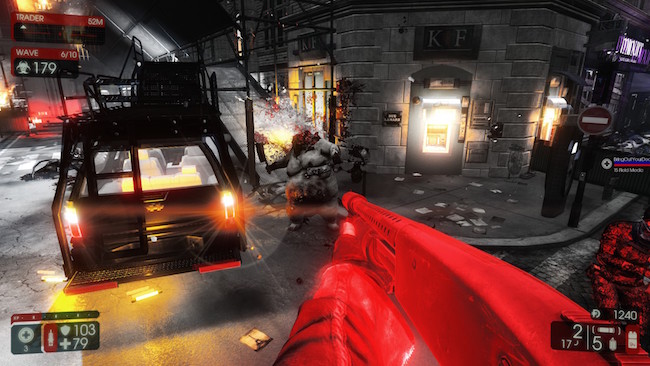
Of course, in Killing Floor tradition the final wave is the boss wave –Killing Floor 1 brought us the Patriarch – a super powerful monster with a brutal melee attack, rockets, automatic guns that would cut you to ribbons and a series of healing syringes. Killing Floor 2’s early access only has one boss monster, the brand-new Hans Volter – though Tripwire plans to have at least three boss monsters in the final release. German Scientist Hans Volter (and his token accent reminiscent of Hogan’s Heroes Colonel Klink) help drive home the tongue-in-cheek nature of the series; much like the Patriarch, he is highly mechanized and throws taunts at the player while firing off relentless volleys of grenades, nerve gas bombs and automatic weapon fire. However, his healing move involves grabbing one player, rendering them immobile and draining life from them while becoming near-impervious to weapons fire. Of course, he can only do this a handful of times, and his overall status is communicated articulately by the colour scheme of his glowing cybernetics, telling you just how far he is from buying the farm.
Currently there are only three maps available; Paris Burning features some neat urban design, and a mix of open and tight spaces to fight in; Outpost is mostly outdoor and very spacious while Biotics Lab recreates the same tight corridor combat from the first game’s namesake. They feel nicely designed, with a nice play on destructible dynamic ambient lighting, and different environmental layouts changing the pacing and tactical approach of the combat each time.
In conclusion, I do believe Killing Floor 2 to not only be a worthy sequel to the first title, but a worthy multiplayer experience in its own right. I’m certainly glad Tripwire took their time on this one to balance the countless variables involved and ensure that, above all else, they’ve produced an incredibly fun, innovative and dynamic multiplayer experience.











